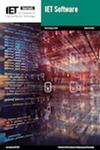基于无限故障nhpp的软件可靠性模型有用吗?
IF 1.5
4区 计算机科学
Q3 COMPUTER SCIENCE, SOFTWARE ENGINEERING
引用次数: 1
摘要
在文献中,无限故障软件可靠性模型(SRM),如Musa-Okumoto SRM(1984),已被证明在定量表征软件测试过程和评估软件可靠性方面是有效的。本文主要研究了基于无限失效(ii型)非齐次泊松过程(NHPP)的srm,并通过与现有基于有限失效(i型)NHPP的srm的比较,对这些srm的性能进行了综合评价。更具体地说,为了描述软件故障检测时间分布,我们假设了11个具有代表性的概率分布函数,这些概率分布函数可分为广义指数分布族和极值分布族。然后,我们将拟合优度和预测性能与相关的11种基于nhpp的i型和ii型srm进行比较。在数值实验中,我们分析了从16个实际开发项目中收集的软件故障计数数据,这些数据在软件行业中通常称为故障计数时域数据和故障计数时间间隔数据(组数据)。利用极大似然法对两种基于nhpp的srm模型参数进行估计。通过对i型和ii型模型的比较,发现ii型模型比现有的i型模型具有更好的预测性能,尤其是在软件测试的早期阶段。本文章由计算机程序翻译,如有差异,请以英文原文为准。
Are Infinite-Failure NHPP-Based Software Reliability Models Useful?
In the literature, infinite-failure software reliability models (SRMs), such as Musa-Okumoto SRM (1984), have been demonstrated to be effective in quantitatively characterizing software testing processes and assessing software reliability. This paper primarily focuses on the infinite-failure (type-II) non-homogeneous Poisson process (NHPP)-based SRMs and evaluates the performances of these SRMs comprehensively by comparing with the existing finite-failure (type-I) NHPP-based SRMs. In more specific terms, to describe the software fault-detection time distribution, we postulate 11 representative probability distribution functions that can be categorized into the generalized exponential distribution family and the extreme-value distribution family. Then, we compare the goodness-of-fit and predictive performances with the associated 11 type-I and type-II NHPP-based SRMs. In numerical experiments, we analyze software fault-count data, collected from 16 actual development projects, which are commonly known in the software industry as fault-count time-domain data and fault-count time-interval data (group data). The maximum likelihood method is utilized to estimate the model parameters in both NHPP-based SRMs. In a comparison of the type-I with the type-II, it is shown that the type-II NHPP-based SRMs could exhibit better predictive performance than the existing type-I NHPP-based SRMs, especially in the early stage of software testing.
求助全文
通过发布文献求助,成功后即可免费获取论文全文。
去求助
来源期刊

IET Software
工程技术-计算机:软件工程
CiteScore
4.20
自引率
0.00%
发文量
27
审稿时长
9 months
期刊介绍:
IET Software publishes papers on all aspects of the software lifecycle, including design, development, implementation and maintenance. The focus of the journal is on the methods used to develop and maintain software, and their practical application.
Authors are especially encouraged to submit papers on the following topics, although papers on all aspects of software engineering are welcome:
Software and systems requirements engineering
Formal methods, design methods, practice and experience
Software architecture, aspect and object orientation, reuse and re-engineering
Testing, verification and validation techniques
Software dependability and measurement
Human systems engineering and human-computer interaction
Knowledge engineering; expert and knowledge-based systems, intelligent agents
Information systems engineering
Application of software engineering in industry and commerce
Software engineering technology transfer
Management of software development
Theoretical aspects of software development
Machine learning
Big data and big code
Cloud computing
Current Special Issue. Call for papers:
Knowledge Discovery for Software Development - https://digital-library.theiet.org/files/IET_SEN_CFP_KDSD.pdf
Big Data Analytics for Sustainable Software Development - https://digital-library.theiet.org/files/IET_SEN_CFP_BDASSD.pdf
 求助内容:
求助内容: 应助结果提醒方式:
应助结果提醒方式:


